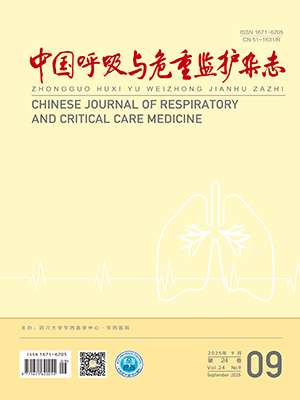| 1. |
Shankar-Hari M, Phillips GS, Levy ML, et al. Developing a new definition and assessing new clinical criteria for septic shock: for the third international consensus definitions for sepsis and septic shock (Sepsis-3). JAMA, 2016, 315(8): 775-787.
|
| 2. |
Seymour CW, Liu VX, Iwashyna TJ, et al. Assessment of clinical criteria for sepsis: for the third international consensus definitions for sepsis and septic shock (sepsis-3). JAMA, 2016, 315(8): 762-774.
|
| 3. |
Vincent J L, Jones G, David S, et al. Frequency and mortality of septic shock in Europe and North America: a systematic review and meta-analysis. Critical Care, 2019, 23(1): 1-11.
|
| 4. |
Barcella M, Pinto BB, Braga D, et al. Identification of a transcriptome profile associated with improvement of organ function in septic shock patients after early supportive therapy. Critical Care, 2018, 22(1): 1-13.
|
| 5. |
Dessimoz C, Škunca N. The gene ontology handbook. Methods in molecular biology. New York: Humana Press, 2017: 1446.
|
| 6. |
Yu G, Wang LG, Han Y, et al. ClusterProfiler: an R package for comparing biological themes among gene clusters. OMICS, 2012, 16(5): 284-287.
|
| 7. |
Franceschini A, Szklarczyk D, Frankild S, et al. STRING v9.1: protein-protein interaction networks, with increased coverage and integration. Nucleic Acids Res, 2013, 41(Database issue): D808-D815.
|
| 8. |
Tyner S, Briatte F, Hofmann H. Network visualization with ggplot2. R Journal, 2017, 9(1): 27-59.
|
| 9. |
Bandettini WP, Kellman P, Mancini C, et al. MultiContrast Delayed Enhancement (MCODE) improves detection of subendocardial myocardial infarction by late gadolinium enhancement cardiovascular magnetic resonance: a clinical validation study. J Cardiovasc Magn Reson, 2012, 14(1): 83.
|
| 10. |
Walter W, Sánchez-Cabo F, Ricote M. GOplot: an R package for visually combining expression data with functional analysis. Bioinformatics, 2015, 31(17): 2912-2914.
|
| 11. |
Patil NK, Guo Y, Luan L, et al. Targeting immune cell checkpoints during sepsis. Int J Mol Sci, 2017, 18(11): 2413.
|
| 12. |
林颖韬, 陈伶莉, 胡雪峰. 免疫细胞的种类、功能及相关疾病概述. 生物学教学, 2020, 45(4): 77-80.
|
| 13. |
Feuerecker M, Sudhoff L, Crucian B, et al. Early immune anergy towards recall antigens and mitogens in patients at onset of septic shock. Scientific reports, 2018, 8(1): 1754.
|
| 14. |
de Pablo R, Monserrat J, Prieto A, et al. Role of circulating lymphocytes in patients with sepsis. Biomed Res Int, 2014, 2014: 671087.
|
| 15. |
Piotrowska M, Spodzieja M, Kuncewicz K, et al. CD160 protein as a new therapeutic target in a battle against autoimmune, infectious and lifestyle diseases. Analysis of the structure, interactions and functions. Eur J Med Chem, 2021, 224: 113694.
|
| 16. |
Tu TC, Brown NK, Kim TJ, et al. CD160 is essential for NK-mediated IFN-γ production. J Exp Med, 2015, 212(3): 415-429.
|
| 17. |
Thomas AK, Maus MV, Shalaby WS, et al. A cell-based artificial antigen-presenting cell coated with anti-CD3 and CD28 antibodies enables rapid expansion and long-term growth of CD4 T lymphocytes. Clin Immunol, 2002, 105(3): 259-272.
|
| 18. |
张安莉, 仇超, 徐建青. 淋巴细胞膜分子CD160结构与功能的研究进展. 中华微生物学和免疫学杂志, 2011, 31(4): 380-384.
|
| 19. |
Miller MC, Mayo KH. Chemokines from a structural perspective. Int J Mol Sci, 2017, 18(10): 2088.
|
| 20. |
Murdoch C, Finn A. The role of chemokines in sepsis and septic shock. Contrib Microbiol, 2003, 10: 38-57.
|
| 21. |
冀林华, 任汉云. 趋化因子及其受体与免疫细胞关系研究进展. 陕西医学杂志, 2008, 37(12): 1678-1680.
|
| 22. |
Venet F, Lepape A, Debard AL, et al. The Th2 response as monitored by CRTH2 or CCR3 expression is severely decreased during septic shock. Clin Immunol, 2004, 113(3): 278-284.
|
| 23. |
Mizukami T, Kanai T, Mikami Y, et al. CCR9+ macrophages are required for eradication of peritoneal bacterial infections and prevention of polymicrobial sepsis. Immunol Lett, 2012, 147(1-2): 75-79.
|
| 24. |
Benvenga MJ, Chaney SF, Baez M, et al. Metabotropic glutamate2 receptors play a key role in modulating head twitches induced by a serotonergic hallucinogen in mice. Front Pharmacol, 2018, 9: 208.
|
| 25. |
Taylor DL, Jones F, Kubota ESFCS, et al. Stimulation of microglial metabotropic glutamate receptor mGlu2 triggers tumor necrosis factor α-induced neurotoxicity in concert with microglial-derived Fas ligand. J Neurosci, 2005, 25(11): 2952-2964.
|
| 26. |
Gohar EY. G protein-coupled estrogen receptor 1 as a novel regulator of blood pressure. Am J Physiol Renal Physiol, 2020, 319(4): F612-F617.
|
| 27. |
Waghulde H, Cheng X, Galla S, et al. Attenuation of microbiotal dysbiosis and hypertension in a CRISPR/Cas9 gene ablation rat model of GPER1. Hypertension, 2018, 72(5): 1125-1132.
|
| 28. |
Pei SJ, Zhu HY, Guo JH, et al. Knockout of CNR1 prevents metabolic stress-induced cardiac injury through improving insulin resistance (IR) injury and endoplasmic reticulum (ER) stress by promoting AMPK-alpha activation. Biochem Biophys Res Commun, 2018, 503(2): 744-751.
|
| 29. |
Van Wyngene L, Vandewalle J, Libert C. Reprogramming of basic metabolic pathways in microbial sepsis: therapeutic targets at last?. EMBO Mol Med, 2018, 10(8): e8712.
|
| 30. |
Dejean AS, Joulia E, Walzer T. The role of Eomes in human CD4 T cell differentiation: a question of context. Eur J Immunol, 2019, 49(1): 38-41.
|
| 31. |
Kong DH, Kim YK, Kim MR, et al. Emerging roles of vascular cell adhesion molecule-1 (VCAM-1) in immunological disorders and cancer. Int J Mol Sci. 2018, 19(4): 1057.
|
| 32. |
Urbahn MA, Kaup SC, Reusswig F, et al. Phospholipase D1 regulation of TNF-alpha protects against responses to LPS. Sci Rep, 2018, 8(1): 10006.
|
| 33. |
Lee SK, Kim SD, Kook M, et al. Phospholipase D2 drives mortality in sepsis by inhibiting neutrophil extracellular trap formation and down-regulating CXCR2. J Exp Med, 2015, 212(9): 1381-1390.
|




